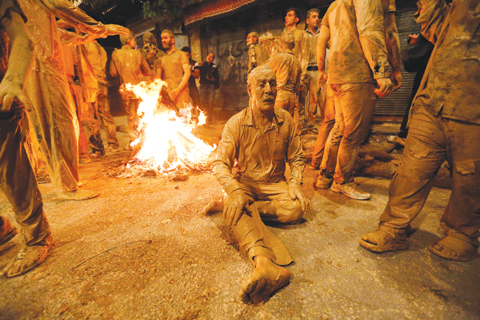 KHORRAMABAD, Iran: Iranian Shiite Muslims sit after rubbing mud on their body during the ‘Kharrah Mali’ (Mud Rubbing) ritual to mark the Ashura religious ceremony in the city of Khorramabad yesterday. —AFP
KHORRAMABAD, Iran: Iranian Shiite Muslims sit after rubbing mud on their body during the ‘Kharrah Mali’ (Mud Rubbing) ritual to mark the Ashura religious ceremony in the city of Khorramabad yesterday. —AFPKHORRAMABAD: A huge burst of flame lights up a pre-dawn backstreet, silhouetting the young men caked from head to toe in brown mud, as chants for Iran's most revered imam rend the air. Khorramabad, a city of around 400,000 sheltered among the Zagros mountains of southwestern Iran, has always done things a little differently on Ashura, the holiest day in Shiite Islam.
Drawing on burial traditions in their native Lorestan province, the men cover themselves in mud as a sign of their grief over the death over 1,300 years ago of Imam Hossein, grandson of the Prophet Mohammed. It is unique to the area, and adds a slightly more festive spirit to a religious day that is known elsewhere in Iran for reducing the faithful to tears as they reflect on the tragic injustice of Hossein's final stand against rival claimants to the leadership of Islam-a battle that remains at the heart of the split between Sunnis and Shiites.
As elsewhere, there are huge processions in which men whip themselves rhythmically to pounding drums-though these days the whips are ceremonial, with the practice of actually lacerating one's back banned by the government and driven underground. The other familiar trappings of Ashura-and the preceding 10-day period of Moharram-are also present, from the near-ubiquitous black clothing, to the stalls that sprout up at every street corner offering free food and drinks to passers-by. But in Khorramabad, there is added mud. Men-and a very few women-come out into the street shortly after the first call to prayer and gather around sandboxes which they fill with rosewater to form a mud bath.
Over the next few hours, thousands of men submerge themselves in the mud and position themselves around burning woodpiles to dry, before proceeding through the streets. "It goes back to our ancient traditions," said Mohammad, a teacher in his thirties, fresh from the mud bath. "People would rub mud on themselves when someone died. The more the person was loved, the more mud people would rub on themselves. Later it was used to mark the death of Hossein because he is really dear to people."
'For the people'
Chants of "Hossein, Hossein, our Lord!" take up periodically and the crowds beat their chests in time to the religious chants playing over loudspeakers. But there are noticeably far fewer tears on display here than in other parts of Iran, and clerics are almost entirely absent for the muddy sections. "This is a celebration for the people, it has nothing to do with the authorities," says one man on the sidelines.
The event has proved increasingly irresistible for photographers and journalists, who swarm around the mud-caked men. Among the snappers is world-renowned director Jafar Panahi, who was banned from making films after the anti-government protests in 2009-10. "There are more photographers here than worshippers," he jokes, only slightly exaggerating. Across Iran, similar processions have taken over the towns and villages, with the streets of Yazd and Tabriz in particular known for turning into seas of black bodies.
It is the one time of year when the whole of Iran feels like it has come out onto the streets, and children enjoy the chance to escape parental control. Yet it is also a time when grown men and women can be reduced to tears by the impassioned recitations and singing that recount the last stand of Hossein and his followers against the massed armies in Karbala in modern-day Iraq-a tale of woe and desperate resistance that runs deep in the Iranian self-image to this day. - AFP










